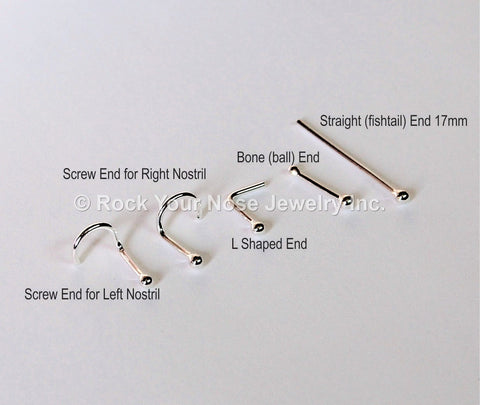How to Size Nose Rings & Studs
Nose Rings
(scroll down for nose studs)
How to choose a great nose ring (hoop):
CHOOSE YOUR NOSE RING SIZE
Measure from your piercing hole to the bottom of your nostril for a starting point.
Method 1 - put a ruler up to your nose. Don't push hard and flatten your nostril. Use the tiny lines of a metric ruler (best) or do it in inches and convert it.
For both methods go from your piercing hole to the bottom of your nostril but not wrapped around
Method 2 - cut a piece of string a couple inches long. Use a pen or marker to put a little mark on it. Place the mark right at your piercing hole and let the string dangle down. Pinch where it touches the bottom of your nostril in the area where you want your ring to sit. Keep pinching it and lay it down and mark the spot where you're pinching. Then with the two marks, measure the distance between them.
Consider the thickness of your nostril - do you have thinner or thicker nostrils?
I measure in millimeters on the INSIDE of the ring – from the inside of one edge to the inside of the opposite edge
See the conversion chart below for millimeters to inches
I use 8mm = ‘fits most’ size, 6mm = really small, and 12mm = really large

For a real life example, here is Nicole wearing an 8mm nose ring in 20G. This one is wrapped in gold wire. You can see the silver ring, where it starts and the approximate thickness of her nostril. Consider your own nostril thickness and piercing placement. A higher piercing needs a larger ring. A piercing lower on the nostril needs a smaller ring.

And here she is again, wearing an 8mm cuff nose ring. The gauge is hidden in her nose because the gauge is the thickness of the wire that goes into your piercing hole. The interior diameter of Nicole's cuff nose ring is 8mm.

CHOOSE YOUR NOSE RING GAUGE
Gauge means how thick the wire is.
22G is thinner & daintier, 20G is a standard (fits most), and 18G is a little thicker
Piercings are more frequently done in 18G but 20G is a close second. 22G piercings are more rare and usually the result of "gauging down" in size because of preferring a thinner ring.
Your piercer could advise you on what you're currently wearing so you can stay consistent.
CHOOSE YOUR NOSE RING MATERIAL
Are you a silver nose ring person? A gold nose ring person? Solid gold, or gold filled? Maybe niobium is just right for you.
Create different looks with different metals – the choice is all yours.
All of my nose rings are nickel free
Nose Studs
End Styles
screw end for left or right nostril
L end (shaped like an L)
L up into the nostril (some designs)
L for left nostril (some designs)
L for right nostril (some designs)
bone end (straight shaft with little ball on the end)
straight shaft 17mm long (otherwise known as fishtail)

My nostril or when you're looking at me? It's your nostril. Put your hand up to your piercing. Which hand is it? That's what side your piercing is on.
Shaft Length:
I make my shafts 6.5mm long
The small "L" part of my L ends are 5mm long, except on the L end for left or right, where it's a little shorter so it doesn't poke into your nostril.
The screw portion of my screw end nose studs is 4.5mm wide and the 'tail' of it points toward the septum.
CUSTOM SIZING
I can make these to a size you require. You need to leave a note for the specific size if you need something other than my standard (eg. "please make my stud with a 7.5mm shaft length). Please don't leave "make them a bit longer, or "make them a bit shorter" in your order notes.

European Sizing
In Europe, the thickness is indicated in millimeters, instead of in gauge.
The conversions are as follows:
24G = .511mm
22G = .644mm
20G = .812mm
18G = 1.02mm
16G = 1.2mm

